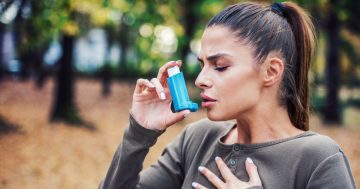
According to Riverina respiratory physician Dr Adriaan Venter, the community may be at risk of experiencing a spike in respiratory conditions such as asthma due to a high pollen count and thunderstorm activity. Photo: File.
Spring may be here but beneath the wondrous green and gold patchwork landscape, with wafts of jasmine and fruit blossoms, hides a multitude of irritants that induce tears, sneezing and wheezing in many people in the community.
Spring also means thunderstorms – of a sudden nature – which can also trigger asthma.
On Thursday 3 September, Murrumbidgee Local Health District (MLHD) launched its annual spring campaign warning people in the Murrumbidgee, South West Slopes and Riverina regions who have breathing difficulties related to asthma and hay fever to prepare now.
MLHD clinical nurse consultant for asthma and respiratory Robyn Paton said asthma flare-ups increase throughout the Murrumbidgee region in spring due to high pollen counts in conjunction with thunderstorm-related weather conditions.
“When preparing for spring, the key message for people who wheeze and sneeze is to visit their GP or respiratory specialist for an assessment of their lung health, obtain a current prescription for preventer, as well as reliever medication and a written asthma action plan, and then use them,” she said.
A handy tool is Charles Sturt University’s online register for people with asthma to receive alerts via email or SMS when thunderstorm asthma risk is elevated.
Local respiratory physician Dr Adriaan Venter said people with asthma need to ensure the condition is totally controlled during this period.
“The devastating thunderstorm asthma epidemic in Melbourne in November 2016, and epidemics that have occurred in the Riverina, are evidence of the dangers the weather can pose at this time,” he said.
“Wheezing and sneezing have been in abundance in recent months. Mix these conditions with elevated levels of pollen and the typical thunderstorms during late spring, and we may be at risk of experiencing another epidemic of respiratory-related conditions such as asthma flare-ups.”
Dr Venter said if someone experiences these symptoms, they need to be assessed for asthma and take preventative treatment which may include preventer medication each day, plus reliever medication as required.
He said people should not just rely on symptomatic treatment, such as Ventolin, if they have breathing problems.
If they have hay fever and sinus issues, these conditions also need to be discussed with their doctor to determine appropriate treatment.
“If breathing difficulties continue when taking a preventer and after taking reliever medication, it is essential to seek medical help immediately,” said Dr Venter.
“We aim for control, and good management means not having any asthma symptoms.”
The annual spring thunderstorm asthma campaign is promoted by the Murrumbidgee Asthma Collaborative, which includes representatives from MLHD, Murrumbidgee Public Health Network, Wagga Wagga Base Hospital, Charles Sturt University, Asthma Australia, and pharmacy and interested community groups.
MLHD has also reminded people that symptoms of COVID-19 can include a dry cough, runny or stuffy nose, shortness of breath, fever and loss of taste or smell. It has asked anyone experiencing any of these symptoms to speak to their GP, or call the Murrumbidgee COVID-19 Hotline on 1800 831 099 to arrange a test.








